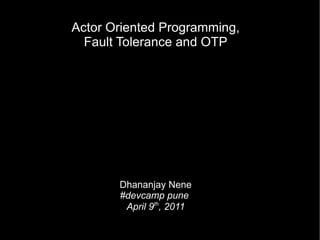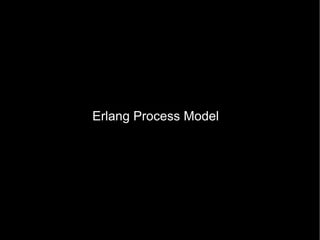Actors, Fault tolerance and OTP
- 1. Actor Oriented Programming, Fault Tolerance and OTP Dhananjay Nene #devcamp pune April 9 th , 2011
- 2. What is the Actor Model ?
- 3. ¡° In computer science, the Actor model is a mathematical model of concurrent computation that treats "actors" as the universal primitives of concurrent digital computation : in response to a message that it receives , an actor can make local decisions, create more actors, send more messages, and determine how to respond to the next message received.¡± ¨C Wikipedia (Actor Model)
- 5. In erlang parlance, each actor is a process
- 6. However thats not the same as an operating system process. A single OS process hosts many erlang processes. An erlang process is far lighter than even a thread.
- 7. Isolation : Processes are isolated. They do not share any memory between themselves. Garbage collection also works independently per processes
- 8. Since processes run concurrently, the inability to share memory between them reduces many of the difficulties associated with conventional multi threaded programming
- 9. Messages : Processes interact with each other by sending each other messages asynchronously
- 10. For asynchronous messaging to work each process has a mailbox of messages and it processes one message at a time from the mailbox
- 11. Introduction : Sleeping Barber Problem
- 12. OTP : Open Telecom Platform
- 13. OTP plays a somewhat similar role as JEE does for Java
- 14. OTP Design Patterns : Application
- 15. Server
- 16. Supervisor
- 17. State Machines
- 18. Event Handling
- 19. Philosophy : Let it crash
- 20. Let it crash actually encouraging higher availability initially seems like an oxymoron
- 21. But what it really emphasises is the ensured continued availability of the overall system rather than the robustness of every small piece that forms it.
- 22. So what features of erlang help fault tolerance?
- 23. Light weight process design allows modeling highly concurrent set of activities
- 24. Shared Nothing / Process Isolation allows any process to fail without directly negatively impacting any other process
- 25. Code demonstrated : Erlang : https://github.com/dnene/sleeping-barber/tree/34616b7c692b8b18eac71d34a7b30b65b2d94e20 Scala ¨C akka https://github.com/dnene/sleeping-barber/tree/34616b7c692b8b18eac71d34a7b30b65b2d94e20
- 26. Ability to link processes, and create supervisor and monitor hierarchy allows graceful resumption of failed services






















